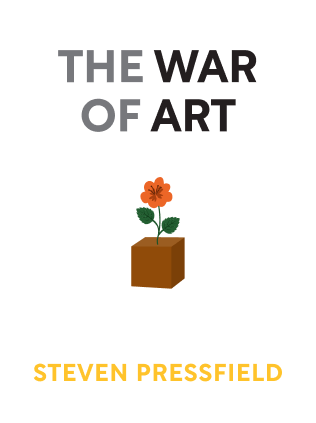

This article is an excerpt from the Shortform book guide to "The War of Art" by Steven Pressfield. Shortform has the world's best summaries and analyses of books you should be reading.
Like this article? Sign up for a free trial here .
What can you learn from The War of Art book? How can you achieve your creative ambitions? How can managing your fears help you to succeed in your chosen field?
The War of Art book spells out the reason you struggle to reach your dreams and provides strategies to help you overcome the obstacles. Each creative person experiences resistance in the form of fear when they approach their true work. When you understand where that fear comes from, how it manifests in your life, and how a commitment to your work can give you the strength to push forward, you will be successful in living your dreams.
Keep reading for the key ideas from The War of Art book.
The War of Art: Book Overview and Key Takeaways
What’s stopping you from fulfilling your dreams? Is it time, family, motivation, fear, or one of several distractions you face on a regular basis? In The War of Art book, Steven Pressfield says it’s all of these things and places them under one umbrella—resistance. Although The War of Art book mostly discusses resistance surrounding creative pursuits, the book speaks to anyone trying to attain personal growth and satisfaction in their life by following their heart’s desire.
In The War of Art book, Pressfield breaks down the enemy within that holds you back from reaching your potential, how to reframe your pursuits for success, and how to tap into your creative power. Understanding resistance and how to push past it is important not only to honor the genius you were born with, but also to ensure you don’t spiral into a state of dissatisfaction with yourself and life.
What Is Resistance?
In The War of Art book, Pressfield introduces his idea of resistance. Resistance is an internal sensation that is more powerful than any external force in stopping you from achieving your goals. It’s the little voice in your head that says you aren’t good enough, strong enough, or motivated enough to start your creative journey. It is a faceless, formless, and heartless energy with the sole purpose of ensuring you never start the work that will lead to your true nature. Whether you’re an artist, inventor, or scientist, resistance flares up each time you start or think about starting the work you were born to do. If left unchecked, resistance will lead you down a road of psychological instability.
Resistance is activated by fear and gains strength every time you give in to that fear. Resistance takes on many forms: procrastination; a fixation with self-soothing or instantly gratifying behaviors, such as drug and alcohol use or entertainment; or a gravitation toward trouble or drama in your life, since they help distract your mind from the important work. Resistance manipulates you by providing what you need to continue avoiding the work you know you must do.
When Do You Feel Resistance?
You only feel resistance when you pursue work or behaviors that will enrich your soul and help you rise to your true calling. The unique talents and desires inherent inside you make up your genius, which is Latin for “inner-guiding spirit.” If something inside of you says you were born to be a writer, an entrepreneur, an advocate for social justice, or the person who will cure cancer, that voice is your genius calling to you. When you hear that call, resistance joins the chorus. Resistance is like a compass needle—it always points due north toward your most important work.
The following are examples of the type of work resistance wishes to thwart:
- Creative arts, such as writing, music, visual art, and performance art
- Entrepreneurial endeavors, such as a new business venture, an invention, or a non-profit organization
- Spiritual or religious awakenings
- Activities aimed to break habits or overcome addiction
- Educational pursuits
- Social or political actions motivated by moral or ethical values
- Personal and emotional growth, including commitments to relationships
- Behaviors that oppose adversity, especially those requiring courage
Resistance targets these pursuits because they mean something to you. They speak to your larger being and purpose in life, so your heart and identity are wrapped up in them. In contrast, resistance doesn’t care about lowly pursuits, such as those explicitly pursued for money or power, because you don’t care about them. Lowly pursuits are ego-driven and embedded in the external world. They do nothing to lift you into a higher plane of existence.
A good rule of thumb—if your heart is not on the line, the work is not the work you were meant to pursue.
How Do You Know Which Pursuits Are the Right Ones?
An imposter doesn’t think twice about their work. They believe they have everything figured out, and they don’t question whether they are good enough. They also don’t put in the work to master the skills required in their endeavor. They assume the persona of a master and move forward like a bull in a china shop. If this is how you feel about your personal pursuits, you’re headed in the wrong path.
Self-doubt, love, and fear are important indicators that your work encompasses your inner genius. When you question whether you have what it takes to be an artist, you signify your passion for the work. True artists have everything to lose, and your self-doubt is the embodiment of that emotional sensation. When you feel doubt, you know you’re getting close to your genius.
Love is the same way. When you love the work you’re doing, you know you’re doing the right work. Loving something with all your heart is terrifying. The risk of losing it makes you feel vulnerable, which is uncomfortable. Resistance will use this to keep you from starting or following through on the work. But you can use this love to bolster you. When you feel love for the work, keep working. That is the only way to overcome resistance.
Fear is tricky because, as stated, fear is what triggers resistance and gives it power. You can use that fear to your advantage, but you must understand what it is you fear. Common fears include loss of freedom, loss of community, loss of stability, and loss of the certainty you feel about your calling. If you fail, you will have to accept that you’re not who you thought you were.
However, the biggest fear is fear of success. Why would anyone fear success? Because if you follow your calling and reach your potential, you will have to do the work to maintain that life. The pressure is on to live up to the success. And you may worry that success will change the comfortable life you are accustomed to.
These fears tell you that what you’re doing or want to do is significant for your life. You can feel the pendulum starting to swing toward your authentic self, and it scares you. That is why fear can be your friend. You will know you are pursuing the right work when you’re surrounded by fear.
Reframing Your Life for Success
The only thing you have to do to win the battle against resistance is do the work. The work is where your creative power lives. You fall into a timeless space where the rest of the world drops away. You are alone on your creative island, and only you have access to this part of yourself. The person you show the world is not the person working with your internal genius.
To reach this creative space, you must be a professional in your work, not an amateur. When you’re an amateur, you dabble in your art whenever inspiration strikes or you’re in the right mood. You’re not committed to your art, and your goals center around fun, money, and status. Resistance loves an amateur because you are easily distracted from the work.
When you’re a professional, you create art because your soul demands it. Your art is a full-time commitment, even if you aren’t getting paid. You sit down to face your art daily because it is part of who you are. You shape your life to include the work as a priority. Resistance hates the professional because you are less likely to cower to fear.
The great thing about being a professional is the access you have to your muse. Each time you sit down and face your art, you open the portal to your artistic space, where the muse resides. Within this universe, your muse conspires to bring you inspiration because you are committed to your art.
How to Become a Professional
You become a professional the moment you decide to commit to your art. But what does being a professional look like? The answer lies in how you approach your day job, or “money-making work.”
- You show up daily and work hard.
- You take criticism from your boss with a grain of salt.
- You are detached from the work because it doesn’t define you.
- You keep working because your livelihood demands it.
Approach your creative work with the same attitudes, and you will be prepared for resistance when it shows up.
Why? Because the only way to defeat resistance is by working. You can’t be precious about the work. You must show up to greet your muse every day. You must learn about your craft so you have the skills needed to use the inspiration the muse provides. You must put the work into the world and be open to criticism. You must detach from the work personally so you can complete it authentically.
A professional understands that fear is part of the work and failure part of the road to success. You know that you must love being miserable because each time you sit down to do your work, you will have to overcome resistance. It is not easy to remain motivated in the face of this formidable foe, but you must if you want the life you were meant to have.
Working like a professional gives you the power to work through fear. Resistance, like any bully, doesn’t know what to do when its target stands up for herself and no longer fears them. When you do the work, you stand up to fear, and resistance slips away. You’ve won the battle for the day, and you are prepared to keep winning in the days to come.
Consciousness and Art
You have a muse waiting in your creative space to give you the inspiration you need to do your work. Some call the muse talent, and others think of it as an angel sent from the gods. However you look at it, the fact remains that when you tap into your creative space, you open your consciousness up to mysterious forces that conspire to serve your work.
When you acknowledge the muse in your artistic life, you counteract feelings of ego that hinder the authenticity of your work. The muse knows things that you don’t. It sees your potential and wants to give you what you need to reach it. The muse rewards the commitment of the professional. Therefore, the only way to summon the muse is simply starting to work.
The muse is just one mysterious force working in your favor. The other comes from you and exists in higher planes of existence, called the Self. When you harness the energy of the muse and power of the Self, you will shove resistance to the side.
Your Self vs. Your Ego
Your Ego is the embodiment of the personal “I,” or the surface mind. The ego operates in the real world. The Self is the larger conscious entity that comprises the individual and collective unconscious minds. Your dreams, intuition, and visions live within the realm of the Self.
The Ego is where resistance lives, and the Self is where the spirits live, including yours and that of your muse. Both the Self and Ego are powerful and battle for position in your mind.
When you are led by your Ego, your main priority is to maintain the status of “I” in the world. The Ego believes that life is finite, so you live in a constant state of fear of losing it. The Ego lives on the surface and manages your day-to-day activities. This aspect of the Ego is valuable in continuing life, but it does nothing for continuing art.
The Self believes in life beyond death. It wanders in a realm where everything is connected through love, and space and time are artificial constructs. Your psychic power lies in the sphere of the Self, and anytime you try to alter your consciousness, you seek to access this higher sphere. The Self does not lie and cannot disguise itself as something it’s not. The Self encompasses the deepest form of who you are.
Your Artist Self
When you sit down to create, you are attempting to access the plane of the Self. You gravitate toward art because you want to grow, evolve, learn, and tap into internal truths. You seek a spiritual awakening to become more enlightened.
The more enlightened you become, the less you rely on Ego. The you that exists within the Self is more powerful than the physical you, so resistance tries to block the path to your awakening. The Ego would rather you didn’t become your authentic self. But your authentic self is the only person you can be if you want to be happy.
Claiming Your Artistic Identity
Identity is important to all of us. We have an inherent need to know where we fit in within society. You define yourself based on your connections, which inform how you act. There are two main forms of connection in society: those based on hierarchy and those based on territory.
Hierarchy vs. Territory
Hierarchy defines you based on your position along a certain social ladder. Territory connects you to certain environments or activities. To reach your creative potential, you must seek your identity from territory, not hierarchy.
Hierarchy is death for the artist. It narrows your scope regarding the work. You strive to find your place within your field, so you measure yourself against those achieving success. You try to shape yourself according to the rank you wish to become. When you look to the outside world to define your worth, you will never be content.
When you look outward instead of inward for validation, you stop doing the work for the sake of the work. You write, paint, or develop your ideas based on what you believe people want to see and will accept. You force yourself to travel down an unauthentic path, and you and the work suffer.
The territory of your art is the creative space inside you. You connect with your muse and higher mind in your territory. Some examples of territories include the canvas for a painter, the stage for a performer, or the blank page for a writer. The only way to claim your territory is by doing the work.
When you work within your territory, you invite their mysterious forces in and promise to serve as a patient servant. You do the work for the sake of the work, and you will be rewarded with insight and guidance from your higher planes of consciousness.
If you’re not sure which place you work from, ask the following questions:
If you’re suffering psychologically, what do you do to make yourself feel better?
- If you call a bunch of friends to receive reassurance, you’re more hierarchical.
- If you turn to the work for solace, you are territorial.
If you were the last person on Earth, would you still create your art?
- If your creations lose meaning because there’s no one to validate your work, you’re hierarchical.
- If you gain sustenance from the act of doing the work without accolades, you are territorial.
A major advantage of the territorial foundation is that it banishes fear. When you work because it is part of who you are and commit to the work, you can never fail. Claim your territory through work, and intruders have no choice but to move on to unclaimed land.
Living Your Creative Life
The only thing that will stop you from achieving your calling is yourself. If you let resistance stop you from doing the work, you will never reach your potential. You will suffer because you know you are meant for more, and the world will suffer because you have not provided the gift you were chosen to give. You can’t predict the outcome of your work, but you can ensure nothing happens if you don’t try. Trust the process, trust the muse, and trust yourself to work like a professional, and you will never fail. Every day you choose to follow your true path in life you win.
The above ideas from The War of Art book will help you overcome resistance and achieve your creative ambitions.

———End of Preview———
Like what you just read? Read the rest of the world's best book summary and analysis of Steven Pressfield's "The War of Art" at Shortform .
Here's what you'll find in our full The War of Art summary :
- Why creative people feel resistance when approaching their true work
- How to break down the wall that holds you back from reaching your potential
- How to tap into your creative power and honor the genius you were born with






